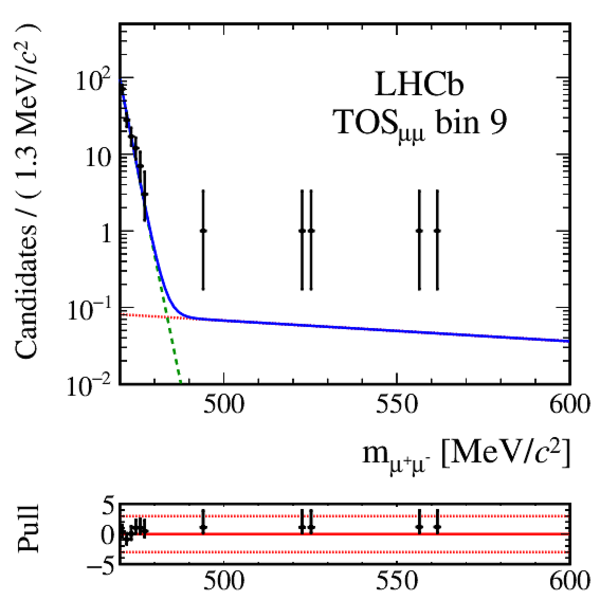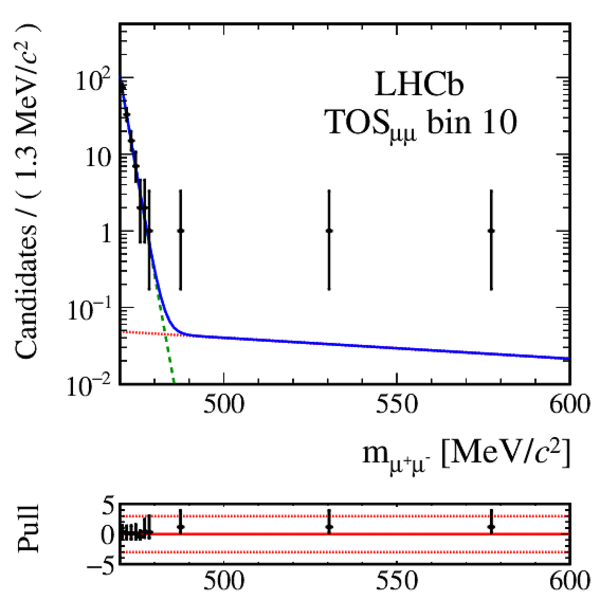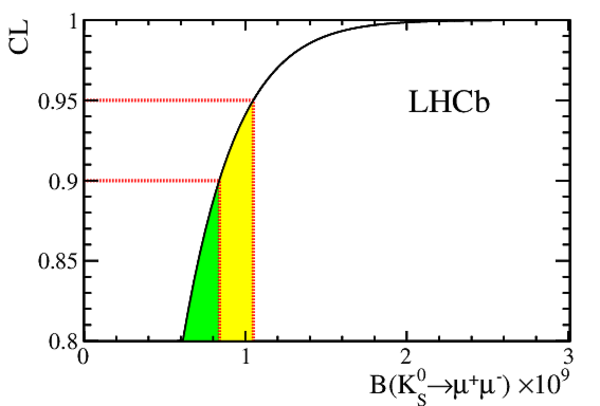Improved limit on the branching fraction of the rare decay $K^0_{\scriptscriptstyle S}\to\mu^+\mu^-$
[to restricted-access page]Information
LHCb-PAPER-2017-009
CERN-EP-2017-101
arXiv:1706.00758 [PDF]
(Submitted on 02 Jun 2017)
Eur. Phys. J. C77 (2017) 678
Inspire 1602477
Tools
Abstract
A search for the decay $K^0_{\scriptscriptstyle S}\to\mu^+\mu^-$ is performed, based on a data sample of proton-proton collisions corresponding to an integrated luminosity of 3 fb$^{-1}$, collected by the LHCb experiment at centre-of-mass energies of 7 and 8 TeV. The observed yield is consistent with the background-only hypothesis, yielding a limit on the branching fraction of ${\cal B}(K^0_{\scriptscriptstyle S}\to\mu^+\mu^-) < 0.8 (1.0) \times 10^{-9}$ at $90\% (95\%)$ confidence level. This result improves the previous upper limit on the branching fraction by an order of magnitude.
Figures and captions
|
Reconstructed mass for $ K ^0_{\mathrm{ \scriptscriptstyle S}} \rightarrow \pi^+\pi^-$ decays in trigger-unbiased events, computed assuming the muon (dashed red line) or pion (solid blue line) mass for the final-state tracks. Candidates satisfy the selection criteria described in the text. |
Fig1.pdf [15 KiB] HiDef png [192 KiB] Thumbnail [183 KiB] *.C file |

|
|
Fits to the reconstructed kaon mass distributions, for the two most sensitive $\text{BDT}_{\rm cb}$ bins in the two trigger categories, TOS $ _{\mu}$ and TOS $ _{\mu\mu}$ . The fitted model is shown as the solid blue line, while the combinatorial background and $ K ^0_{\mathrm{ \scriptscriptstyle S}} \rightarrow \pi^+\pi^-$ double misidentification are overlaid with dotted red and dashed green lines, respectively. For each fit, the pulls are shown on the lower smaller plots. |
Fig2a.pdf [18 KiB] HiDef png [240 KiB] Thumbnail [193 KiB] *.C file |

|
|
Fig2b.pdf [18 KiB] HiDef png [228 KiB] Thumbnail [185 KiB] *.C file |

|
|
|
Fig2c.pdf [17 KiB] HiDef png [236 KiB] Thumbnail [187 KiB] *.C file |

|
|
|
Fig2d.pdf [17 KiB] HiDef png [232 KiB] Thumbnail [185 KiB] *.C file |

|
|
|
Confidence level of exclusion for each value of the $ K ^0_{\mathrm{ \scriptscriptstyle S}} \rightarrow \mu^+\mu^-$ branching fraction. The regions corresponding to $90\%$ and $95\%$ CL are emphasised in green (dark shading) and yellow (light shading), respectively. |
Fig3.pdf [13 KiB] HiDef png [119 KiB] Thumbnail [97 KiB] *.C file |

|
|
Animated gif made out of all figures. |
PAPER-2017-009.gif Thumbnail |

|
Tables and captions
|
Values of the single candidate sensitivity $\alpha_{ij}$ and the number of candidates $N^{K}_{ij}$ compatible with the $ K ^0_{\mathrm{ \scriptscriptstyle S}}$ mass (reconstructed mass in the range $[492,504] {\mathrm{ Me V /}c^2} $), for each $\text{BDT}_{\rm cb}$ bin $i$ and trigger category $j$. Only statistical uncertainties are given. The first uncertainty is uncorrelated, while the second is fully correlated among the $\text{BDT}_{\rm cb}$ bins of the same trigger category. |
Table_1.pdf [58 KiB] HiDef png [101 KiB] Thumbnail [49 KiB] tex code |

|
|
Relevant systematic uncertainties on the branching fraction. They are separated, using horizontal lines, into relative uncertainties on (i) $\alpha_{ij}$, (ii) on the signal yield from the signal model used in the mass fit, and (iii) on the branching fraction, obtained combining the two categories, from the background model. |
Table_2.pdf [46 KiB] HiDef png [112 KiB] Thumbnail [49 KiB] tex code |

|
Created on 27 April 2024.
